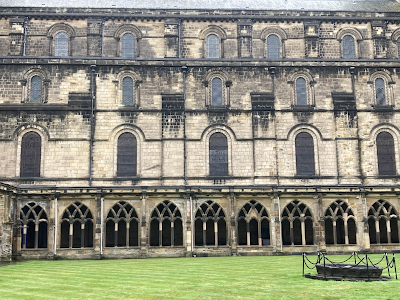The following is a little tour of Durham Cathedral I gave our group of pilgrims. The purpose was to get oriented in this tremendous space so that each participant might form a clear idea of how they wanted to spend the limited free time they had there. (We had driven from Lindisfarne and needed to beat the tides coming and going, so we were on a bit of a schedule!)
Perhaps this post can serve as a meditation whether or not readers are able to visit Durham.
These are pilgrim spaces created to provide shelter and access for others who, like us, traveled from afar to the Cathedral in a sense of devotion.
Drawn into the spirit of Cuthbert, we prayerfully gather in awe and anticipation.
From the outside: Romanesque, rounded, a massive fortification - the most monumental Norman edifice we know.
Inside, "as big as all outdoors" - towering, sturdy, its pillars like a grove for giants.
There is a sensation of being outside even though we are inside, a feeling that some land and air deemed sacred have been enclosed with a sublime grandeur of reverence. Indeed, signs of nature surround us, not only in the natural building materials of wood and stone but also in the fossils that fill the locally-sourced Frosterley Marble.
Above the tomb of this saint and historian we find his beautiful prayer:
Christ is the morning star, who,
when the night of this world is past,
brings to his saints the promise of the light of life
and everlasting day.
This area is airy and bright, and the windows through which the light reaches us incorporate hundreds of fragments of older windows giving a lovely sense of new life to what was broken. This befits the intellect and writings of Bede and is an inspiring image of how we might meaningfully arrange what sometimes seem to be disjointed beliefs, experiences, and parts of our lives.
4. Cuthbert's Window
While the Cathedral is unmistakably old and remarkably preserved in its singular style (except for the "new" Gothic part), it has room for the modern which somehow gives it a distinct quality without upsetting the impression of consistency. There is a balance - or better yet, a cooperation - of deep, deep roots providing a platform for the flowering of fresh branches.
This, too, can be a model for our lives as we build on the ancient insights of a historic faith manifested anew in our own lives.
5. The Clock
This artifact reminds us that, despite its spiritual import, this cathedral was, itself, an assertion of political presence and served as a makeshift prison.
After the 1650 Battle of Dunbar, as many as 3000 Scots were imprisoned here with well over 1000 of them perishing within its walls.
During that time, the clock was untouched while virtually every other wooden thing was burned for warmth. Why was it spared? According to legend, it was passed over due to the emblem of a thistle in its design, a key symbol in Scottish heraldry.
Standing in the transept and pondering this story, we are reminded of the embattled world the Church inhabits even today.
6. The Shrine of Saint Cuthbert
In my experience, this space induces an attitude of humility.
Perhaps it is the magnitude of Cuthbert's devotion reflected in the present-day simplicity of the room.
Or maybe it is the striking tester above the tomb and the touching statue of Cuthbert holding King Oswald's head.
Beyond that, there is a resonance of the prayer rail with that of the rock in Jerusalem's Garden of Gethsemane Church of All Nations.
As the Spirit weaves these together, our impulse is worshipful silence.
7. Chapel of the Nine Altars
Unfortunately, this area was closed during our visit, but we could still see into much of its space, a space of inspiration and imagination.
Here is demonstrated something of how beauty can serve as a portal to heavenly things. In the richness of its symbols and references, its constellation of altars projects a vision of God through the lives of saints such as Margaret, Hilda, and Aiden, not to mention the soulful Pietà of Fenwick Lawson whose The Journey we had seen in St. Mary's back on Lindisfarne.








